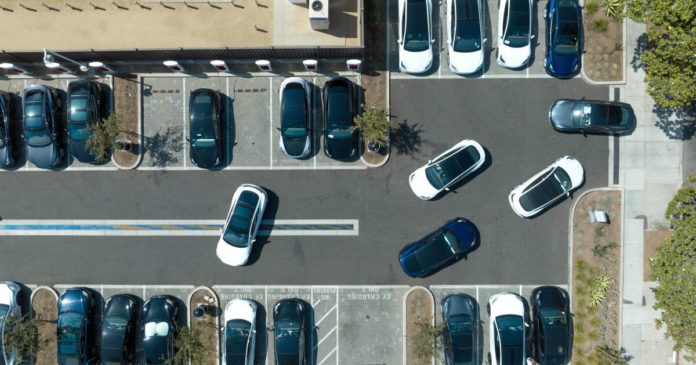If you’re looking for a sign that California’s transition to zero-emission transportation is well underway, you’ll be encouraged by the state’s latest sales numbers for electric cars.
They show that 18.8% of new vehicle sales — nearly 1 in 5 — were zero-emission in 2022. That’s a big jump from 12.4% the year before, and a more than a doubling of sales in just two years. Excluding plug-in hybrid vehicles, which run on a gas engine and a battery, about 16% of new sales in California are now fully electric, far exceeding the nationwide rate of 5.8%.
That sales are picking up after years of puttering along in the single digits is unquestionably good news for California’s fight against climate change and air pollution. They show a promising trajectory for the state’s first-in-the-nation rules, adopted last year, to phase out sales of new gas-fueled automobiles by 2035.
But look under the hood and you’ll see the stubborn, underlying reality: The majority of new electric vehicles sold were higher-end models that remain unaffordable to most Californians. More than 70% of fully electric vehicles sold in California last year were Teslas, as has been the case each year since 2018.
The fact that California’s electric vehicle market remains dominated by Teslas and other vehicles dealers classify as luxury and near-luxury is evidence of a socioeconomic divide that remains a barrier to California’s push to replace polluting, fossil-fueled vehicles with electric models powered by clean, renewable energy.
The 2022 sales figures indicate the most popular electric models remain significantly more expensive than the bestselling gas-powered ones. Tesla’s Model 3 and Model Y are California’s top two bestselling EVs. Even with recent price cuts, you can expect to pay at least $45,000 for a Model 3, while the Model Y goes for about $54,000 and up.
Compare that to the Toyota Camry, one of California’s top-selling gas-powered cars, with a price tag starting at around $27,000. That’s in line with nationwide figures showing electric vehicles sell, on average, for about $17,000 more than gas-powered ones.
There are lower-priced electric vehicles, such as the Chevrolet Bolt and Nissan Leaf, which can be purchased for less than $30,000. But those models sold fewer than 17,000 vehicles combined in California last year, though not because buyers weren’t interested. Supply chain constraints and limited production of these models reduced inventories, drove up prices and discouraged would-be buyers.
“There is a demand for less expensive models, but automakers are being cautious because it’s a new technology,” said Edmunds analyst Jessica Caldwell. But those supply chain issues are easing and dealer markups above sticker price are starting to come back down, she said.
Officials with the California Energy Commission, which released the sales data, said the 2022 numbers also show Ford, Chevrolet, Hyundai and Kia are making inroads against Tesla, and that they are planning a wider selection of affordable models in the coming years, which will be good for competition. The new electric cars being sold today will be available at lower cost on the used market in the coming years, and will eventually get into the hands of lower-income people, they said.
But Californians in the low-income communities hit hardest by dirty air need the benefits of electric vehicles the most and shouldn’t have to wait years for them to trickle down. Zero-emission cars don’t only provide cleaner air, but also economic advantages, including lower fuel and maintenance costs compared with gas-fueled cars. But for now, their distribution remains highly uneven. A Sacramento Bee analysis last year found that electric cars were more than 15 times as prevalent in the state’s wealthiest ZIP Codes than in the poorest.
To be fair, California has recognized this environmental injustice and offers incentives of up to $9,500 toward the purchase of an electric car, such as the Clean Vehicle Rebate Program and Clean Cars 4 All, that include income limits to help disadvantaged residents. But these programs have been plagued by insufficient and uneven funding and long waiting lists, and are far too difficult for most Californians to navigate. Furthermore, California’s zero-emission vehicle incentive programs are facing a $1.1-billion reduction next fiscal year due to a projected $22.5-billion budget deficit.
New federal tax credits for EVs in the Inflation Reduction Act may help increase sales among middle- and lower-income Californians, but state regulators should not count on that. They must act more aggressively to ensure that electric vehicles are available to motorists of all income levels through car-sharing programs, easier-to-use subsidies and building charging stations accessible to apartment renters and others who don’t have a way to charge at home.
Transportation accounts for about half of California’s greenhouse gas pollution, and we need to switch to electric vehicles as quickly as possible to meet our climate targets. But that transition will be unjust and unattainable as long as they remain an out-of-reach luxury for most people.

